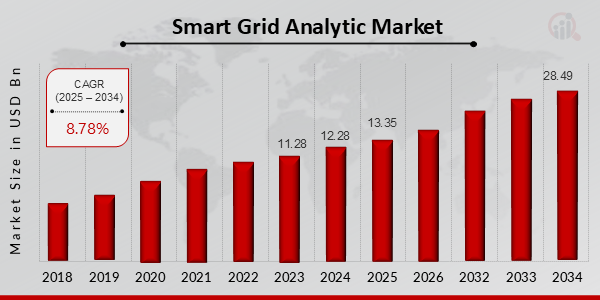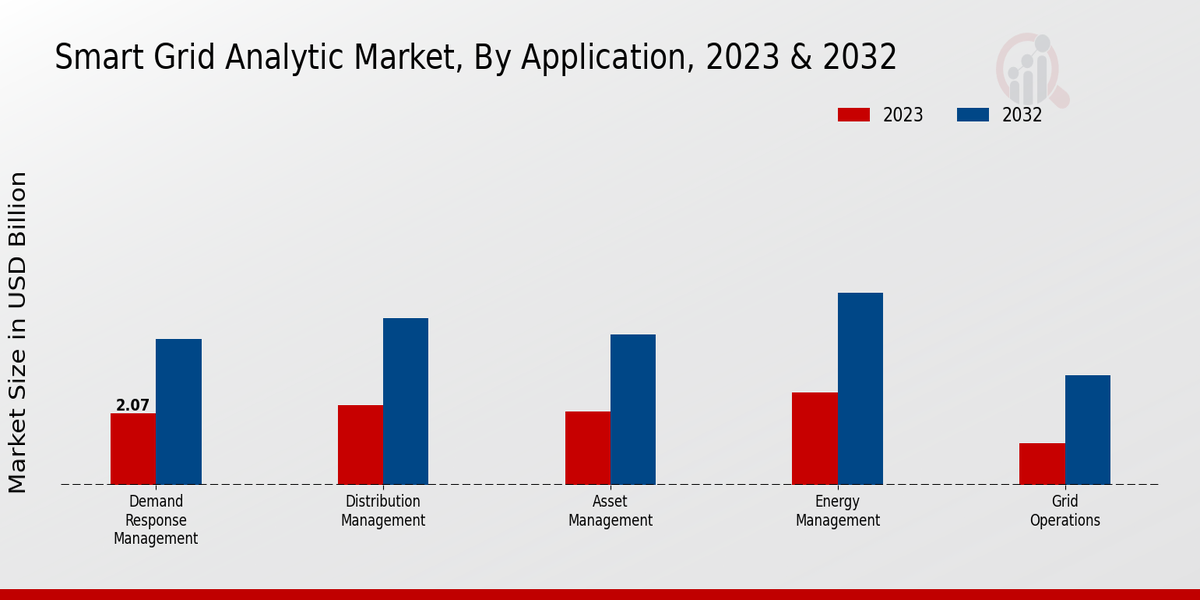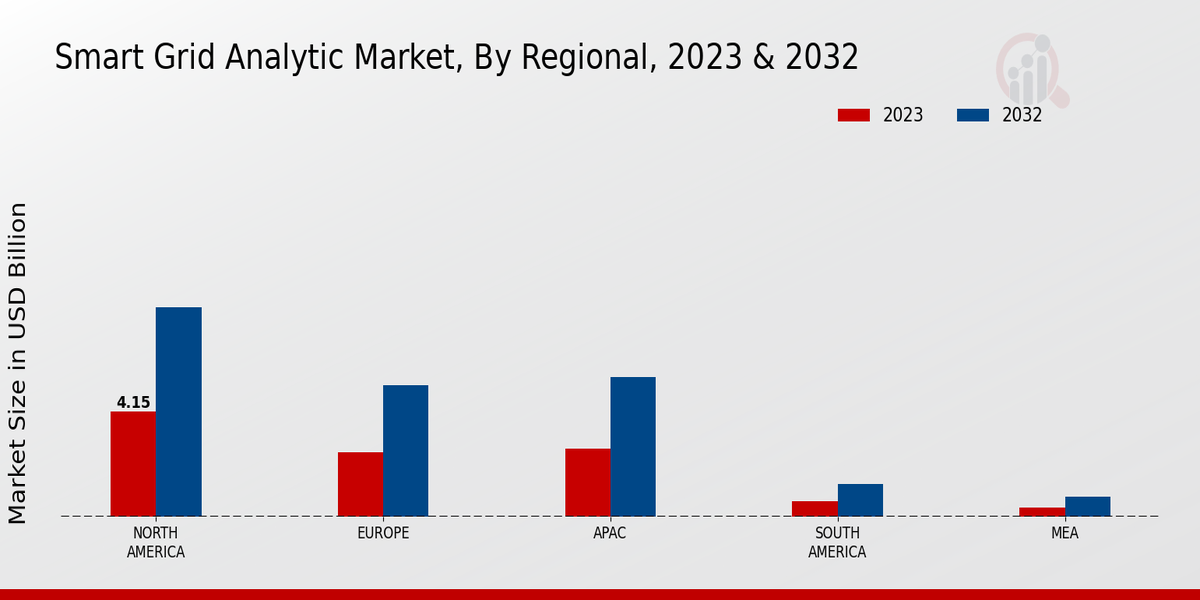Smart Grid Analytics Market Overview
Smart Grid Analytic Market is projected to grow from USD 13.35 Billion in 2025 to USD 28.49 Billion by 2034, exhibiting a compound annual growth rate (CAGR) of 8.78% during the forecast period (2025 - 2034). Additionally, the market size for Smart Grid Analytic Market was valued at USD 12.28 billion in 2024.
Key Smart Grid Analytic Market Trends Highlighted
The smart grid analytic market is witnessing significant growth driven by the increasing demand for efficient energy management and the integration of renewable energy sources. One of the key market drivers is the rise in energy consumption across various sectors, which compels utilities to adopt smarter solutions to manage resources effectively. This trend is further fueled by government regulations promoting energy efficiency and sustainability. As utilities seek to enhance operational efficiency, the need for advanced analytics to process and interpret vast amounts of data becomes essential. This evolution not only optimizes grid performance but also improves reliability and reduces costs.
Amid this rapidly changing landscape, opportunities exist for companies to develop innovative solutions that leverage artificial intelligence and machine learning for predictive analytics. The integration of these technologies can enhance decision-making processes, helping utilities anticipate demand fluctuations and identify potential outages before they occur. Additionally, the shift towards decentralized energy systems opens avenues for smart grid analytics applications to manage localized energy production and consumption, creating a more resilient grid infrastructure. Recent times have seen a trend towards greater collaboration between technology providers and utility companies.
Partnerships can facilitate the development of tailored solutions that meet specific operational challenges. Moreover, there's an increasing focus on consumer engagement through smart meters and home energy management systems. These tools not only contribute to energy conservation but also empower consumers to manage their energy usage more effectively. As the market evolves, embracing these trends will be critical for stakeholders aiming to capitalize on the growth potential within the smart grid analytic market.
Figure 1: Smart Grid Analytics Market Size, 2025-2034 (USD Billion)

Source: Primary Research, Secondary Research, MRFR Database and Analyst Review
Smart Grid Analytic Market Drivers
Increasing Demand for Energy Efficiency
The smart grid analytic market is experiencing significant growth driven by the increasing demand for energy efficiency. As energy consumption continues to rise globally, utilities and consumers are seeking innovative solutions to optimize energy use. Smart grid analytics enhance energy management by providing real-time data and insights into consumption patterns, which leads to more informed decision-making regarding energy usage.
This demand for energy efficiency is further fueled by government incentives and regulatory frameworks aimed at reducing carbon emissions and promoting sustainable practices. Stakeholders in the energy sector are increasingly adopting smart grid analytics to facilitate demand response, enhance operational efficiency, and improve service reliability. This movement towards a more efficient energy ecosystem is poised to drive scalable advancements in smart grid technologies, further propelling the smart grid analytic market. Additionally, with urbanization and industrialization accelerating in various regions, the need for smart solutions that can intelligently manage and distribute energy resources has never been more critical.
Consequently, the smart grid analytics solutions that promote energy efficiency will play a pivotal role in shaping the future of energy management while ensuring consumer satisfaction and compliance with regulatory standards.
Government Initiatives for Smart Grid Development
Government initiatives promoting smart grid development are significantly contributing to the growth of the smart grid analytic market. Various governments worldwide are investing in smart grid infrastructure to enhance energy reliability, security, and sustainability. By creating robust policies and funding opportunities, governments are encouraging the integration of advanced analytics in power distribution and management.
Growing Investment in Renewable Energy Sources
The growing investment in renewable energy sources is a crucial driver for the smart grid analytic market. With the transition towards sustainable energy solutions, analysts are essential in managing the variability and complexities associated with renewable energy generation.
This trend is fostering the demand for smart grid analytics, which allows for efficient integration of renewables into existing grid infrastructures.
Smart Grid Analytic Market Segment Insights
Smart Grid Analytic Market Application Insights
The remarkable increase reflects the increasing need for efficient resource management and improved operational capabilities in the energy sector.
Among the various applications, Demand Response Management stood out with a valuation of 2.07 USD billion in 2023, expected to rise to 4.24 USD billion in 2032, highlighting its critical role in balancing energy supply and demand while enhancing grid reliability. Distribution Management, with a valuation of 2.31 USD billion in 2023 and forecasted to reach 4.85 USD billion by 2032, played a significant part in facilitating the smooth functioning of power distribution networks, ensuring effective energy delivery to consumers.
Asset Management, valued at 2.13 USD billion in 2023, earmarked to reach 4.37 USD billion by 2032, signifying the importance of tracking and optimizing the lifecycle of physical assets to minimize losses and improve return on investment. Energy Management also held a substantial position, valued at 2.67 USD billion in 2023 and expected to grow to 5.58 USD billion by 2032, illustrating its necessity in monitoring energy consumption patterns to promote sustainability.
Lastly, Grid Operations, though the least valued at 1.2 USD billion in 2023, is expected to reach 3.18 USD billion by 2032, reflecting its growing significance in maintaining the overall efficiency and reliability of power delivery systems. Each of these applications plays a pivotal role in the overarching framework of the smart grid analytic market, driving its evolution and responsiveness to the modern energy landscape, which is increasingly integrating advanced analytics for enhanced decision-making capabilities.
The steady market growth is attributable to the rising demand for smart grid solutions and the urgency for more resilient and efficient power systems to meet the evolving needs of consumers and industries alike. Overall, understanding the dynamics of these applications is essential to grasp the broader trends influencing the smart grid analytic market revenue and segmentation as it adapts to the demands of a rapidly changing technological environment.

Source: Primary Research, Secondary Research, MRFR Database and Analyst Review
Smart Grid Analytic Market Software Type Insights
The smart grid analytic market is witnessing a notable growth trajectory driven by diverse software types that enhance operational efficiencies and data management capabilities. The Advanced Distribution Management System represents a significant component, effectively optimizing energy distribution and minimizing outages. Meanwhile, the Energy Management System is increasingly vital for improving energy efficiency and integrating renewable energy sources.
Data Management Software facilitates real-time data processing, supporting utility companies in making informed decisions promptly. Lastly, Network Management Software is crucial for monitoring network health and performance, ensuring reliability and security in energy delivery. The segmentation of the smart grid analytic market unveils a dynamic landscape where software advancements contribute significantly to market growth. Emerging technologies in each software type further provide opportunities to innovate and enhance grid management practices.
As the market expands, insights derived from smart grid analytic market data and statistics highlight significant trends and strategic drivers while also presenting challenges in implementation and integration across legacy systems.
Smart Grid Analytic Market Deployment Type Insights
The growth is influenced significantly by the deployment type of the analytics solutions, which include On-Premises and Cloud-Based options. On-Premises solutions have a substantial presence, primarily favored by organizations that prioritize data security and control over their infrastructure, making this deployment type crucial for sectors that handle sensitive information. In contrast, Cloud-Based solutions are gaining traction due to their scalability and accessibility, enabling businesses to access analytics tools without the burden of extensive upfront infrastructure costs.
As these deployment types continue to evolve, the smart grid analytic market is anticipated to see increasing demand driven by the need for efficient energy management and enhanced operational performance. The segmentation of deployment types thus not only highlights the distinct preferences of end-users but also underscores the overall diversity and adaptability of the market in addressing varied organizational needs.
Smart Grid Analytic Market End User Insights
The market caters to various end users, notably the Utilities, Government, and Industrial sectors, each contributing to the overall landscape in unique ways. Utilities form a critical component as they leverage smart grid analytics for operational efficiency and enhanced service delivery, which is essential for meeting increasing consumer demands. The Government segment also plays a vital role, as regulatory bodies drive the need for efficient energy management and sustainability initiatives.
The Industrial sector increasingly adopts smart grid analytics to optimize energy usage, reduce costs, and improve production processes. Overall, the smart grid analytic market revenue growth is driven by the need for improved energy management, the integration of renewable sources, and the rising demand for smart technologies. As the market evolves, the segmentation reflects varying priorities and needs, showcasing the importance of analytics in shaping modern energy landscapes. The robust growth trajectory signifies the rising emphasis on data-driven decision-making, amplifying the relevance of each end user in the broader smart grid analytic market.
Smart Grid Analytic Market Regional Insights
The smart grid analytic market is projected to show substantial growth in the regional segment, with notable revenues emerging from various regions. North America held the majority position, achieving a valuation of 4.15 USD billion in 2023, expected to rise to 8.27 USD billion by 2032, driven by advanced technology adoption and robust infrastructure. Europe followed with a significant market value of 2.56 USD billion in 2023, growing to 5.21 USD billion, reflecting increasing investments in sustainable energy solutions. The APAC region, valued at 2.68 USD billion in 2023, demonstrated a noteworthy growth trend to 5.51 USD billion, highlighting the growing demand for smart technologies in developing countries.
In contrast, South America's contribution stood at 0.63 USD billion in 2023 with a projected increase to 1.32 USD billion, signifying slower growth due to economic factors but potential for future expansion. Meanwhile, the MEA region, the least dominant with a valuation of 0.36 USD billion, anticipates growth to 0.81 USD billion, driven primarily by emerging energy needs and investments in smart grid technologies.
Overall, the market's growth reflects an increasing focus on efficiency, sustainability, and the need to integrate renewable energy sources.

Source: Primary Research, Secondary Research, MRFR Database and Analyst Review
Smart Grid Analytic Market Key Players and Competitive Insights
The smart grid analytic market is witnessing significant growth driven by the need for advanced data management systems in energy distribution and consumption. This market integrates advanced analytics with smart grid technologies to improve the efficiency, reliability, and sustainability of power systems. Companies operating in this sector are leveraging cutting-edge technologies such as big data analytics, cloud computing, and artificial intelligence to derive actionable insights from complex data sets generated across the power grid.
As competition intensifies, businesses are not only focusing on reducing operational costs but are also enhancing customer satisfaction and regulatory compliance through improved energy management solutions. The landscape is marked by a mix of established players and emerging startups, each striving to innovate and capture a larger share of the market by offering unique value propositions that address the evolving needs of utility providers, consumers, and regulatory bodies.
Microsoft has established a strong foothold in the smart grid analytic market through its robust cloud-based solutions and advanced analytical capabilities. The company benefits from its widespread brand recognition and a solid reputation for developing intelligent analytics tools that optimize energy consumption and operational efficiency. Microsoft’s Azure platform supports applications that enhance data interoperability and provide utility companies with the insights needed to predict energy demand and manage resources effectively.
The integration of artificial intelligence and machine learning into their analytics offerings enables clients to not only monitor their energy consumption but also to implement predictive maintenance strategies, thereby minimizing downtime and enhancing service reliability. Microsoft's commitment to innovation and partnership with a wide range of stakeholders positions it favorably within this competitive market.
Oracle is a key player in the smart grid analytic market, known for its comprehensive suite of software solutions tailored to the energy sector. The company's deep industry expertise allows it to develop tools that empower utilities to harness data for actionable insights. With a focus on real-time analytics, Oracle helps energy providers optimize grid operations and increase reliability while managing the complexities associated with renewable energy integration and demand response strategies.
The company’s strong emphasis on security and data governance further strengthens its appeal, providing assurance to clients regarding the protection of sensitive information. Oracle's established relationships with utility operators and its continuous investment in next-generation technology place it as a formidable competitor in the smart grid analytics space, enabling it to drive innovation in energy management and sustainability initiatives.
Key Companies in the smart grid analytic market Include:
-
Microsoft
-
Oracle
-
IBM
-
Schneider Electric
-
Siemens
-
ArcGIS
-
ABB
-
Alstom
-
SAP
-
General Electric
-
Schneider
-
Honeywell
-
Itron
-
Cisco Systems
Smart Grid Analytic Market Developments
Recent developments in the smart grid analytic market reflect a surge in investment and innovation among key players such as Microsoft, Oracle, and IBM, focusing on enhancing data analytics capabilities to improve energy efficiency and integration of renewable sources.
Companies like Schneider Electric and Siemens are also advancing their offerings through the incorporation of AI and machine learning, aiming to optimize grid operations and reduce costs. In terms of current affairs, significant growth in market valuation has been noted, propelled by increasing demand for smart grid technologies and regulatory support for sustainable energy practices.
Additionally, notable mergers and acquisitions have occurred, particularly among these major players, consolidating resources and technology to enhance their market positions. Companies such as ABB and Alstom are strategically aligned to bolster their analytics capabilities, while SAP and General Electric continue to expand their portfolios through partnerships and collaborations.
The overall market sentiment remains positive, driven by technological advancements and the urgent need for smarter energy solutions, which is set to redefine the dynamics of the Smart Grid Analytic landscape.
Smart Grid Analytics Market Segmentation Insights
-
Smart Grid Analytic Market Application Outlook
-
Demand Response Management
-
Distribution Management
-
Asset Management
-
Energy Management
-
Grid Operations
-
Smart Grid Analytic Market Software Type Outlook
-
Advanced Distribution Management System
-
Energy Management System
-
Data Management Software
-
Network Management Software
-
Smart Grid Analytic Market Deployment Type Outlook
-
On-Premises
-
Cloud-Based
-
Smart Grid Analytic Market End User Outlook
-
Utilities
-
Government
-
Industrial
-
Smart Grid Analytic Market Regional Outlook
-
North America
-
Europe
-
South America
-
Asia Pacific
-
Middle East and Africa
| Report Attribute/Metric |
Details |
|
Market Size 2024
|
12.28 (USD Billion)
|
|
Market Size 2025
|
13.35 (USD Billion)
|
|
Market Size 2034
|
28.49 (USD Billion)
|
|
Compound Annual Growth Rate (CAGR)
|
8.78% (2025 - 2034)
|
|
Report Coverage
|
Revenue Forecast, Competitive Landscape, Growth Factors, and Trends
|
|
Base Year
|
2024
|
|
Market Forecast Period
|
2025 - 2034
|
|
Historical Data
|
2019 - 2023
|
|
Market Forecast Units
|
USD Billion
|
| Key Companies Profiled |
Microsoft, Oracle, IBM, Schneider Electric, Siemens, ArcGIS, ABB, Alstom, SAP, General Electric, Schneider, Honeywell, Itron, Cisco Systems |
| Segments Covered |
Application, Software Type, Deployment Type, End User, Regional |
| Key Market Opportunities |
Enhanced data integration solutions, AI for predictive maintenance, Real-time energy consumption analytics, Increased regulatory support and funding, and Demand response management optimization |
| Key Market Dynamics |
Increasing demand for energy efficiency, Government regulations and initiatives, Advances in data analytics technology, Growing investment in smart infrastructure, and Rising renewable energy integration |
| Countries Covered |
North America, Europe, APAC, South America, MEA |
Frequently Asked Questions (FAQ) :
The smart grid analytic market is expected to be valued at 28.49 USD billion by 2034.
The expected CAGR for the smart grid analytic market is 8.78% from 2025 to 2034.
North America is projected to have the largest market share, with an estimated value of 8.27 USD billion in 2032.
The market value for Demand Response Management is expected to reach 4.24 USD billion in 2032.
Some key players include Microsoft, Oracle, IBM, Schneider Electric, and Siemens among others.
The estimated market value for Distribution Management is projected to be 4.85 USD billion in 2032.
The Energy Management segment was valued at 2.67 USD billion in 2023.
The forecasted market size for Asset Management is anticipated to be 4.37 USD billion in 2032.
The APAC region is expected to grow significantly, reaching an estimated value of 5.51 USD billion in 2032.
The market size for Grid Operations is expected to be valued at 3.18 USD billion in 2032.

















